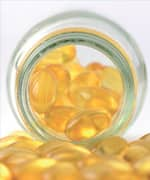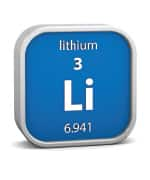Life Extension Magazine®
Higher Vitamin D Levels Linked with Improved Prostate Cancer Survival
 |
In an article in Cancer Epidemiology, Biomarkers & Prevention, researchers at the National Cancer Institute document an association between higher serum vitamin D levels and an increased chance of surviving prostate cancer.*
The current investigation included 1,000 participants in the Alpha-Tocopherol, Beta-Carotene Cancer Prevention Study who were diagnosed with prostate cancer following enrollment. Just over 360 subjects died from their disease over 23 years of follow-up from the time of diagnosis. Serum 25-hydroxyvitamin D levels and other factors were measured upon enrollment and questionnaires concerning diet and medical history were completed by all participants.
Among men whose vitamin D levels were among the top 20% of subjects, there was a 28% lower average adjusted risk of dying from prostate cancer compared to those whose levels were among the bottom 20%. The effect was stronger among those who survived more than 3.3 years.
Editor’s Note: “Our findings that higher 25(OH)D reduces the most clinically relevant prostate cancer outcome, disease-specific mortality, if true, could have important public health implications, including whether vitamin D supplementation should be considered for men diagnosed with prostate cancer,” the authors conclude.
*Cancer Epidemiol Biomark Prev. 2016 Jan 25.
Philanthropist Donates $250 Million to Fund Cancer Research
 |
Sean Parker, 36, co-founder of the file-sharing computer service Napster and former president of Facebook, is donating $250 million to cancer research via his philanthropic Parker Foundation.*
The newly created Parker Institute for Cancer Immunotherapy will concentrate on this developing field, which harnesses the body’s immune system to fight cancer cells.
The institute comprises more than 300 researchers and more than 40 laboratories, including New York’s Memorial Sloan Kettering; Stanford Medicine; the University of California, Los Angeles; the University of California, San Francisco; Houston’s; University of Texas MD Anderson and the University of Pennsylvania in Philadelphia. The focus will be on three key areas of research: modifying a patient’s own immune system T cells to target a tumor, studying ways to boost patient response to current immunotherapy drugs, and research to identify other novel targets to attack a tumor.
Parker hopes the grant will foster collaboration amongst various research centers. “Any breakthrough made at one center is immediately available to another center without any kind of intellectual property entanglements or bureaucracy,” said Parker.
Editor’s Note: Parker says the death of his friend Laura Ziskin, who produced the films Pretty Woman and Spider-Man, raised his awareness of the need to overhaul cancer research. Ziskin died of the disease in 2011.
*Available at: http://www.latimes.com/science/sciencenow/la-sci-sn-cancer-immunotherapy-research-silicon-valley-20160412-story.html. Accessed April 12, 2016.
Decreased Bioavailable and Total Vitamin D Predict Greater Cardiovascular Event Risk
 |
Results of a study presented at the American College of Cardiology Scientific Sessions reveal an association between vitamin D (total and bio-available) levels and lower risk of major adverse cardiovascular events including heart failure, stroke, and heart attack.*
“Many epidemiological studies have shown that [low] total circulating levels of 25-hydroxyvitamin D [25(OH)D] are strongly associated with poor cardiovascular outcomes,” note Heidi T. May, PhD, MSPH, and colleagues. “However, 85%-90% of circulating vitamin D is bound to vitamin D binding protein or albumin, and levels obtained may not be truly reflective of the vitamin D available to act on target cells.”
Acting on the results of observational studies, the researchers determined levels of total serum 25(OH)D and 25(OH)D bound to albumin and vitamin D binding protein in 4,200 men and women.
“Our study found that low levels of both total vitamin D and bioavailable vitamin D appear to be associated with poor cardiovascular outcomes,” Dr. May reported.
Editor’s Note : Bioavailable vitamin D includes that which is bound to albumin but not vitamin D binding protein.
*American College of Cardiology Scientific Sessions. 2016 Apr 2.
Meta-Analysis Affirms Association Between Omega-3 and Lowered Inflammation
A meta-analysis published in PLOS One found more evidence of a reduction in pro-inflammatory factors in association with supplementation with marine-derived omega-3 fatty acids.*
The researchers selected 18 randomized controlled trials involving 826 subjects for their review. Trials included those that evaluated the effects of fish oil (which contains EPA and DHA) or EPA alone on levels of prostaglandin E2, thromboxane B2, or leukotriene B4.
The meta-analysis uncovered a significant association between omega-3 supplementation in reduction in thromboxane B2 in the blood of participants at high risk of cardiovascular disease and in leukotriene B4 in the neutrophils of unhealthy subjects. Reductions in leukotriene B4 occurred only with 14 or more weeks of treatment with omega-3 fatty acids.
“High quality randomized controlled trials are needed to explore the effects of marine-derived omega-3s on different pro-inflammatory factors in subjects with different health status,” concluded the authors.
Editor’s Note: “Several arachidonic acid-derived eicosanoids exert their significant influence on the inflammatory response,” write the authors. Authors stated previous research that “Prostaglandin E2 is involved in the classic signs of inflammation and possesses both pro-inflammatory and anti-inflammatory actions; thromboxane A2, formed by platelets, macrophages and polymorphonuclear leukocytes, can induce vasoconstriction and promotes aggregation of platelets as well as adhesiveness of polymorphonuclear neutrophils; leukotriene B4 (LTB4) can not only increase vascular permeability and enhance local blood flow by stimulating neutrophil secretion, but also stimulate other inflammatory substances.”
*PLOS One. 2016 Jan.
Whey Protein for Breakfast Could Help Manage Diabetes
 |
A study reported at the annual meeting of the Endocrine Society found a benefit for the inclusion of whey protein at breakfast by individuals with type II diabetes.*
The study included 48 overweight and obese type II diabetics with an average age of 59. Participants were instructed to consume a large breakfast, medium-sized lunch and small dinner that provided the same amount of daily calories for 23 months. Subjects were assigned to breakfasts that consisted of whey protein shakes, other proteins such as eggs and tuna, or carbohydrates. Hemoglobin A1c and other factors were measured at the beginning and end of the study.
The group who received the whey protein shake for breakfast had less hunger, lower glucose spikes following meals and a greater reduction in hemoglobin A1c compared with the other groups. “The whey protein diet significantly suppresses the hunger hormone ghrelin,” lead author Janiela Jakubowicz, MD, noted.
Editor’s Note: “A high-calorie protein breakfast, medium-sized lunch, and small dinner is a proven successful strategy for weight loss, improved satiety, and reduced glucose spikes throughout the day in people with obesity and type II diabetes,” Dr. Jakubowicz stated. “However, the benefits of high protein content at breakfast also depend on the protein source and quality. Whey protein powder, which is a byproduct of milk during cheese production, induced greater satiety and reduction of glucose spikes after meals compared to other protein sources such as eggs, soy, or tuna.”
*Annual Meeting of the Endocrine Society. 2016 Apr 1.
Lithium Extends Life in Flies
 |
A study published in Cell Reports found longer life for flies that were given lithium, a chemical element and drug used to stabilize mood in bipolar disorder.*
Researchers gave male and female flies high or low doses of lithium chloride or sodium chloride during adulthood or later in life. Flies that received low-dose lithium lived 16% longer than average and had a maximum lifespan that was 18% longer than controls, which the researchers attribute to blockage of glycogen synthase kinase-3 (GSK-3) and activation of a protein known as NRF2 that aids in the defense of cells against damage.
“We studied the responses of thousands of flies in different conditions to monitor the effects of lithium and how it extends life,” coauthor Dr. Ivana Bjedov stated. “We found low doses not only prolong life but also shield the body from stress and block fat production for flies on a high-sugar diet.”
Editor’s Note : “Identifying a drug target for aging is a crucial step in achieving this and by targeting GSK-3, we could discover new ways of controlling the aging process in mammals, including humans,” predicted first author Jorge Iván Castillo-Quan of University College London.
*Cell Rep. 2016 Apr 7.
Testosterone Therapy Improves Sexual Function in Diabetic Men
 |
An article appearing in BJU International reveals better sexual function in men with type II diabetes and severely depressed testosterone levels who were treated with testosterone undecanoate.*
The study included 189 men, among whom 107 had mild hypogonadism and 87 had severe hypogonadism as demonstrated by low total and free serum testosterone levels. Participants received 1,000 mg testosterone undecanoate or a placebo at the beginning of the study and at 6 and 18 weeks. Questionnaires that assessed erectile function, intercourse satisfaction, orgasmic function and desire were administered prior to treatment and at 6, 18 and 30 weeks.
After 30 weeks, significant improvement in erectile function was noted by the severely deficient men treated with testosterone. Intercourse satisfaction and desire also improved at 6, 18, and 30 weeks in the severely deficient testosterone-treated group.
Editor’s Note: Lead author Geoffrey Hackett of the Heart of England Foundation NHS Trust commented that “The study’s results also suggest that trials of testosterone therapy should be for a minimum of 6 months and not shorter periods as suggested by some guidelines.”
* BJU Int . 2016 Apr 28.
Meta-Analysis Shows Ginseng’s Benefits in Treating Diabetes
 |
Researchers at China’s Zhejiang University provide evidence of a beneficial effect for ginseng in men and women with impaired glucose tolerance or type II diabetes.*
Yun-mei Yang and colleagues selected eight trials that included 195 participants treated with ginseng and an equal number of control subjects. The analysis revealed improvements in fasting glucose, post-meal insulin levels, and insulin resistance, as well as a reduction in triglycerides and total and low-density lipoprotein (LDL) cholesterol among ginseng-treated subjects.
Editor’s Note: As possible mechanisms for ginseng, Dr. Yang and colleagues suggest modulations of insulin production and secretion, glucose metabolism, glucose uptake and inflammation, and activation of the activated protein kinase (AMPK) pathway. Their research suggests that ginseng may be more beneficial for patients who have not started antidiabetic drug therapies than those already being treated.
*Medicine. 2016 Feb.
Supplements May Prevent Hereditary Deafness
 |
Findings from a study appearing in Scientific Reports suggest a role for a combination of free radical scavengers in the prevention of a common form of hereditary deafness caused by mutations in the connexin 26 gene.*
“Many babies born with a genetic mutation that causes deafness pass their newborn screening test but then lose their hearing later in life,” explained co-author Glenn Green, MD, CS. “These patterns suggest that for some children, there may be an opportunity to potentially save cells present at birth.”
In mice with a deletion of connexin 26, prenatal or postnatal supplementation with beta-carotene, vitamins C and E, and magnesium slowed hearing loss progression and improved hearing thresholds. “Our findings suggest that a particular high dose of mineral and vitamin supplements may be beneficial to one genetic mutation,” observed senior author Yehoash Raphael, PhD, of the University of Michigan.
Editor’s Note : Co-author Josef Miller, PhD, who developed the formula, noted that lowering overstimulation-related oxidative stress has been shown to protect the ear’s sensory hair cells. Additionally, free radical scavengers have been shown to preserve cell connections impacted by connexin 26 loss.
Decreased Vitamin C Levels Found in Patients Treated for Hematologic Malignancies
 |
An article appearing in Results in Immunology documents the finding of decreased serum levels of vitamin C in patients with hematologic malignancies that include leukemia, multiple myeloma, and non-Hodgkin lymphoma.*
“As ascorbic acid has a major influence on (re)generation of immune cells in vitro, we executed an observational study in which ascorbic acid serum values of patients with hematological malignancies treated with and without hematopoietic stem cell transplantation were compared with those of healthy volunteers to see if low ascorbic acid levels should be considered of importance regarding immune recovery of these patients,” explained authors Mirelle Huijskens and colleagues.
The researchers measured vitamin C levels in 79 healthy volunteers and 42 hematology-oncology patients treated with chemotherapy or hematopoietic stem cell transplantation. While healthy subjects had median serum ascorbic acid levels of 1.14 mg/dL, those with hematologic malignancies had levels of 0.36 mg/dL per liter.
Editor’s Note : The authors add: “Since ascorbic acid might be crucial for immune function and for in vitro development and expansion of T and natural killer cells from stem cells, we are currently studying the function and recovery of immune cells while patients are on treatment for various malignancies, and determine the correlation of ascorbic acid serum and leukocyte levels and the possible effect of vitamin C supplementation.”
*Results Immunol. 2016 Jan 12;6:8-10.
FDA Fast Tracks Potential Breakthrough Glioblastoma Treatment
A new treatment for a particularly aggressive form of brain cancer has been granted breakthrough status and is being fast-tracked by the Food and Drug Administration.*
As reported on CBS’s 60 Minutes, the first test subject was 20-year-old Stephanie Lipscomb, who began experiencing headaches in 2011. She was diagnosed with a large glioblastoma tumor and told she had months to live. After having 98% of the tumor removed, her cancer returned. Lipscomb then volunteered for an experimental treatment at Duke University. Today, she is free of a type of cancer that had previously been regarded as an almost-certain death sentence.
The treatment, devised by molecular biologist Matthias Gromeier, utilizes a genetically reengineered polio virus which attacks cancer cells but is harmless to the patient.
Gromeier explains that human cancers “develop a shield of protective measures that make them invisible to the immune system…by infecting the tumor, we are actually removing this protective shield, and enabling the immune system to come in and attack.”
Editor’s note: If you or someone you know has recurrent glioblastoma—that is, you have failed at least one conventional treatment, and you only have one area of tumor and are fully mentally coherent and able to walk and function normally, you may qualify to participate in the Duke University study. Go to www.lifeextension.com/glioblastoma for details.
*www.cbsnews.com/news/polio-cancer-treatment-duke-university-60-minutes-scott-pelley. Accessed May 16, 2016.

